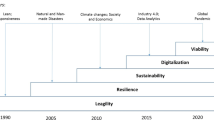Abstract
Success in the Build-Operate-Transfer (BOT) projects mainly depends on choosing a right project to propose. However, it is very difficult to identify a preliminary feasible one at the up-front project development process due to the uncertainties involved. When choosing a probable project to propose, the developers in most cases rely on their experience, intuition, or gut feelings. It is expected that they will improve the chances of deciding a viable project enough to propose if the methodical formalism is provided that guides to systematically recognize the risk factors inherent in the project environment, their impact on project feasibility and strategic alternatives to enhance them. The main objective of this research is to develop a go/no-go decision model as the formalism. Based on the review of diverse decision-making theories, the Multi-Attribute Decision Analysis Method (MADAM) is identified as a suitable theoretical background to developing the formalism. Five BOT experts are invited to put their experience in the model development. A numerical example is presented to demonstrate the computational procedures of the model developed.
Similar content being viewed by others
References
Bell, D.E., Raiffa, H. and Tversky, A. (1988).Descriptive, normative and prescriptive interactions in decision making Decision Making: Descriptive, Normative and Prescriptive Interactions, Cambridge University Press, New York, pp. 9–30.
Call, H.J. and Miller, W.A. (1990). “A comparison of approaches and implementations for automating decision analysis”. Reliability Engineering and Systems Safety, 30, pp. 115–162.
Clemen, R.T. (1992).Making hard decisions: an introduction to decision analysis, Duxbury Press, Bermont, CA.
Decision Programming Language: Advanced Version User Guide (1992).ADA decision systems, Menlo Park, CA.
Gomez-Ibanes, J.A. and Meyer, J.R. (1991).Private toll roads in the united states: the early experience of virginia and california, John F. Kennedy School of Government, Harvard University, Cambridge, MA.
Green, S.D. (1992).A smart methodology for value management, The Chartered Institute of Building, London, UK.
Keeney, R.L. and Raiffa, H. (1993).Decisions with multiple objectives: preference and value tradeoffs, Cambridge University Press, New York.
LaPiere, R.T. (1952).Methods in social research, McGraw-Hill Series in Sociology and Anthropology, New York.
MacCrimmon, K.R. and Wehrung, D. (1986).Taking risks: the management of uncertainty, The Free Press, New York.
Matheson, J.E. (1992)Strategic decision quality, Strategic Decisions Group, Menlo, CA.
Miles, M.E., Hanley, R.L. and Berens, G. (1996).Real estate development: principles and process, The Urban Land Institute, Second Edition, Washington, D. C.
Ock, J.H. (1998).Integrated decision process model (IDEPM) for the development of the build-operate-transfer highway project proposals, A Dissertation for the Degree of Doctor of Philosophy, The University of Colorado, Boulder, Colorado.
Schaevitz, R.C. (1993).Private sector role in U.S. toll road financing issues and outlook, Transportation Research Board 1197, National Research Council, Washington, D.C., pp. 1–8.
Simon, H. (1955).Administrative behavior (2 nd Edition), Free Press, New York.
The Request for Proposal for the Washington State Public-Private Initiatives in Transportation Program. (1994). Washington State Dept. of Transportation, Seattle, WA.
Tiong, R.K. (1996) “CSFs in competitive tendering and negotiation model for BOT projects.”J. Constr. Engineering and Mgmt., ASCE, Vol. 122(3), pp. 205–211.
Tiong, R.K., Yeo, K.T. and McCarthy, S.C. (1992). “Critical success factors in winning BOT contracts.”J. Constr. Engineering and Mgmt., ASCE, Vol. 118(2), pp. 217–228.
Williams, C.E. and Conrad, S.H. (1996). “The return of the private toll road-the dulles greenway”. Construction Business Review, pp. 42–46.
Author information
Authors and Affiliations
Corresponding author
Additional information
Former Director at the Ministry of Construction and Transportation.
The manuscript for this paper was submitted for review on December 31, 2001.
Rights and permissions
About this article
Cite this article
Ock, J.H., Han, S.H. Selecting a viable Build-Operate-Transfer (BOT) project to propose. KSCE J Civ Eng 6, 203–216 (2002). https://doi.org/10.1007/BF02829145
Issue Date:
DOI: https://doi.org/10.1007/BF02829145




